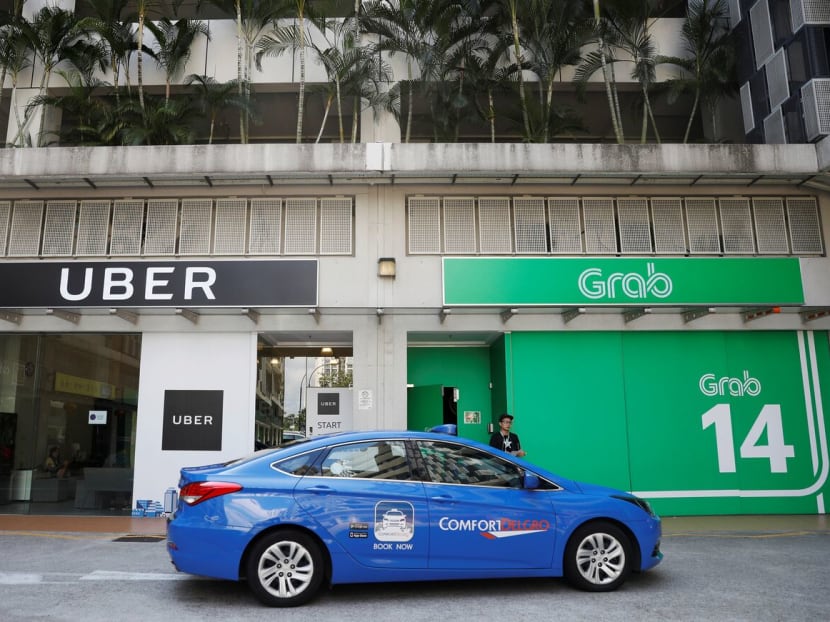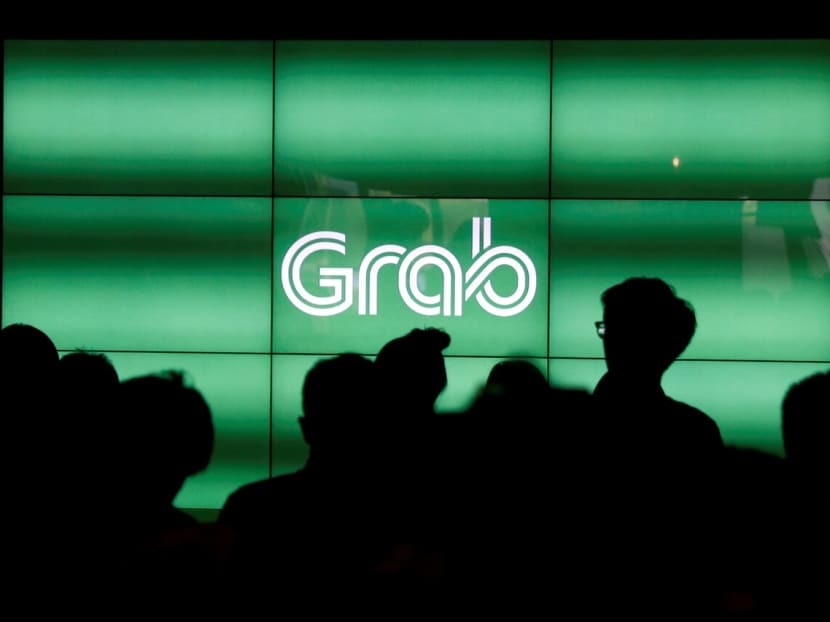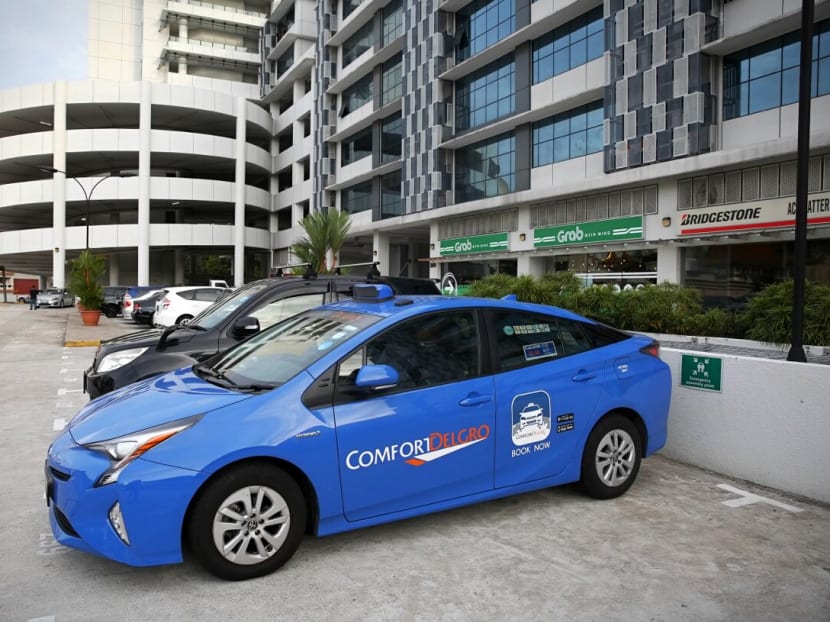The Big Read: When the music stops — Uber-less reality hits commuters and drivers
For five years, long-suffering commuters and taxi drivers in Singapore could hardly believe their luck as the taxi industry was turned on its head by ride-hailing firms. But it was too good to be true. While the situation today is still a far cry from circa 2013 — when Grab and Uber made their first forays into Singapore — the demise of competition and Grab’s subsequent moves in light of its new-found dominance have left many feeling hard done by.

On March 26, after months of speculation, Grab announced its acquisition of Uber’s South-east Asia operations, including in Singapore.
SINGAPORE — These days, Ms Charissa Kow, 25, who frequently takes a Grab ride from her house in Woodlands to her workplace in Alexandra Road, finds herself spending S$20 to S$25 for the 16km trip — or up to one fifth more than what she used to spend less than two weeks ago
She told TODAY: "I used to toggle between the Uber and Grab app in the past, usually one would have a promo code and as a result I would save around S$3 to S$5 every trip."
Another commuter, Mr Bok Chek Yang, laments that fares for short trips on Grab have also increased since early this year. "A 10-minute ride within my estate in Bedok has gone up to S$8… but for the same trip, it was only S$6 last year," said the 38-year-old administrative coordinator.
Private-hire car drivers are feeling the pinch, too. Mr Muhammad Syahmi, 25, used to rake in between S$100 and S$200 a day as a private-hire car driver for Grab after deducting commission, petrol costs and rent, but his income has fallen by as much as 50 per cent — largely due to a reduction in incentives doled out by the ride-hailing firm.

Mr Muhammad Syahmi's income has fallen by as much as 50 per cent, due to a reduction in incentives doled out by the ride-hailing firm. Photo: Nuria Ling/TODAY
Recalling how he used to be able to take home a bonus of S$620 for completing 60 peak-hour trips, he said: "That was the incentive for a good six, seven months last year but recently, completing the same amount of peak-hour trips would only give me an additional S$130."
With his earnings taking a hit, being a full-time Grab driver is no longer an attractive proposition. He intends to stop driving soon and get another job.
For five years, long-suffering commuters and taxi drivers in Singapore could hardly believe their luck as the taxi industry was turned on its head by ride-hailing firms: Commuters enjoyed low fares — sometimes rides were even free, thanks to generous promotions and discounts — and complaints of not being able to get a ride during rainy days or peak hours became a distant memory. Droves of taxi drivers, as well as others, also flocked to Grab or Uber which offered flexible hours and attractive earnings as they duked it out and hired drivers aggressively in a bid to gain market share quickly.
But it was too good to be true.
On March 26, after months of speculation, Grab announced its acquisition of Uber's South-east Asia operations, including in Singapore.

Grab announced its acquisition of Uber's South-east Asia operations in March. Photo: Reuters
The deal is under review by the Competition and Consumer Commission of Singapore (CCCS), and as part of interim measures, the Uber app was kept in operation until May 7. Now, less than two weeks after Uber officially exited the Singapore market, commuters and drivers are feeling the impact.
Make no mistake about it, the situation is still a far cry from circa 2013, when Grab and Uber made their first forays into Singapore. "There is no doubt that consumers are better off today. The market has expanded tremendously, rides are more available, passengers don't have to stand by the road, with the uncertainty of not getting a vehicle," said transport economist Walter Theseira from the Singapore University of Social Sciences (SUSS).
However, the demise of competition — at least for the time being — and Grab's subsequent moves in light of its new-found dominance have left many feeling hard done by.
"I used to be able to drive whenever I want. I just had to clock the number of trips, but now I have no choice. I have to work during peak hours if I want to get the incentives," said a Grab driver who gave his name as Mr Sofian.
According to him, Grab has stopped giving out incentives to drivers for completing a certain number of trips while still rewarding them for completing jobs during peak hours.
COMMUTER WOES
Several commuters interviewed by TODAY said they are forking out about S$3 to S$5 more for each Grab ride these days, mainly because the firm no longer dishes out discounts and promotional codes like it used to before.
However, Grab has maintained that its fare structure "remains the same" after it bought out Uber's regional operations.
In reply to queries from TODAY about the commuters' experience with higher fares, a Grab spokesperson would only say that fares are determined by demand and supply.
The spokesperson said: "Dynamic fares continue to be calculated based on a base distance, with a dynamic surcharge that will be applied based on factors including demand and supply in that particular point in time, traffic conditions and estimated time taken for the journey."
Speaking on the last day of Uber's operations in Singapore, Grab Singapore country head Lim Kell Jay confirmed that the promotional codes and incentives which Grab users previously enjoyed have made way for perks on its loyalty programme GrabRewards.
These promotions had been "trending down" even before its acquisition of Uber's South-east Asia operations, Mr Lim had said.
Previously, commuters were offered limited discounts of about S$3 or more per ride by using promotional codes when making bookings. Now, they can redeem perks such as shopping gift cards and frequent flyer miles.
Meanwhile, incentives for private-hire drivers have also been scaled back, as Grab looks at other ways to lower the drivers' operating cost and maintain or increase their income. For example, the firm is working with fuel companies and fleet partners to offer cheaper petrol and rent. It is also looking at giving drivers "more jobs within the same period of time" to allow them to earn more, Mr Lim had said.
Speaking to TODAY, experts noted that Grab is scaling back on the incentives and discounts in order to recoup its losses from the days of fierce competition for market share.
"Grab will continue experimenting and testing (the) limits, while the market is still rationalising," said Associate Professor Lawrence Loh of the National University of Singapore Business School.
DRIVERS FEELING THE BRUNT
Between commuters and private-hire drivers, it appears that the latter group is feeling the brunt of the firm's business manoeuvres.
The drivers reported that not only has the quantum of the incentives gone down, the variety has also been cut.
Grab does not publish a full list of its incentive policies. Incentive details "are updated on a weekly basis" and can be found on the driver's app, it said.
Anecdotally, several drivers told TODAY that they have noticed the extent of the reduction and the type of incentives offered seemed to differ between individual drivers. There should be greater transparency, they said.
Previously, Mr Sofian said he used to be eligible for two types of drivers' incentives: A weekly total incentive, which is a lump sum for completing a certain number of trips, and a peak-hour incentive, which gives him an additional bonus only if he completes trips during the peak hours.
However, since the beginning of May, he was only offered the peak-hour incentive. It has not only resulted in his earnings falling by 30 per cent, but also meant that he no longer could enjoy flexible hours if he wanted to make ends meet.
"It's just not worth it, I am getting much less for the same number of hours put in," he said. Having driven for Grab for more than two years, he said he might stop driving if his income continues to fall.
Another Grab driver, Ms Rennu Mahajan, 57, said the firm had replaced her weekly incentive with a monthly one since the second week of this month.
Going forward, experts said drivers may have to contend with further tweaking of the incentives, as Grab experiments and tries to determine what is most cost-effective or how to better meet commuter demand.
In other words, this would see Grab tweaking incentive schemes as it deems fit, and translate into the firm having greater control of its drivers.
Said Dr Theseira: "It is in Grab's interest to maximise a vehicle, because they earn off a driver's commission. So, if they observe that a driver is not utilising his vehicle during the peak hours, it might want to increase their availability rate during high-demand hours by changing their incentive scheme."
He added: "This is different from a cab company in that it doesn't really care when and how long you drive, so as long as you are able to afford rent."
CHANCE FOR TAXI FIRMS TO 'GET BACK INTO THE GAME'
Notwithstanding the CCCS' concerns over Grab's monopolistic powers in the private-hire car industry, experts believe the traditional taxi companies — which have been floundering since their business was massively disrupted — have a window of opportunity to get back into the game.
Last month, TODAY reported that traditional taxi operators were reporting a jump in the number of Uber drivers seeking to join or return to them. Subsequently, ComfortDelGro — the only taxi operator which has not partnered Grab — announced on May 7 that it is adding 200 new hybrid Hyundai Ioniqs to its taxi fleet. This would be the first addition to its fleet in almost 1.5 years, the company said. Just days later, the company placed a tender notice in the Straits Times for 500 more hybrid sedans.

ComfortDelGro announced that it is adding 200 new hybrid Hyundai Ioniqs to its taxi fleet. Photo: Nuria Ling/TODAY
Meanwhile, analysts believe the worst might be over for ComfortDelGro, with the taxi industry "turning the corner", as Maybank Kim Eng put it in its latest research report on the firm.
Maybank Kim Eng analyst John Cheong said: "(ComfortDelGro's) management has turned more positive on the taxi segment as it's starting to see increased demand from drivers who switched fromprivate-hire cars, as they find taxis relatively more stable."
If Grab is concerned about recovering its expenses, then it is "good news for the taxi industry", said SUSS urban transport expert Park Byung Joon.
"The days when ride-hailing companies were bleeding through their noses are over, now the playing field for drivers is level," said Dr Park, noting that the incomes of private-hire car drivers were previously inflated due to the incentives dangled by ride-hailing firms.
A STATE OF EQUILIBRIUM?
Mr David Kwan, 51, is among the private-hire car drivers who have regretted making the switch from a traditional taxi operator. Mr Kwan, who joined Grab earlier this month, said he used to take home about S$60 a day as a private-hire car driver for Uber. However, his income has fallen by as much as 30 per cent since Uber's operations in Singapore officially ceased. "At this rate, there is no harm going back to driving a taxi," said Mr Kwan, who intends to go back to his old trade once his vehicle rental contract expires in July.
Reflecting a drop in commuter demand, Mr Kwan said bookings have dropped. Last week, for example, he had to wait "half an hour for one booking". Now, he takes home between S$40 and S$45 a day.
Mr Kwan said he used to make as much as about S$2,500 a month as a private-hire car driver, but he was unsure if his earnings as a taxi driver would "still be as high" when he rejoins a taxi operator.
Still, driving a cab could mean a more stable income, he said. "Plus, driving a taxi, sometimes you can get company bookings, I can also go to the airport and hotels to queue for passengers," he added.
Assoc Prof Loh cautioned that if the trend of disgruntled drivers leaving were to continue, Grab's business would be hit. "They have to play their cards right, no monopoly is permanent. If they lose their drivers, they lose their business," he said.
As things stand, commuters are still better off today, compared to the days when only traditional taxi operators were around, the experts reiterated. The underlying pricing system adopted by ride-hailing companies such as Grab also makes more economic sense, they added.
"Surge pricing generates value, because those people who really want a vehicle badly are more or less guaranteed a vehicle if they are willing to pay the price for it. In the past, it was a matter of luck — whether your call or booking is picked up by a cab driver," said Dr Theseira.
At the same time, the traditional taxi operators continue to provide an additional option for commuters. "Sometimes when the surge prices are too high, I'll just call a cab," said Ms Cherie Loh, 25, a business efficiency associate.
She noted that commuters like herself also use the taxis' metered fare as a benchmark. "If the Grab price far exceeds the usual cab amount, I'll forgo the Grab ride. At the end of the day I'm still glad I have the option (of a) cab," she added.
As for whether drivers would be better off working for traditional taxi operators or ride-hailing companies in the foreseeable future, Dr Theseira said it is hard to tell. It depends on a wide range of factors such as the hours spent on the road, the amount of flexibility that a driver wants, and various components of their earnings.
"Sometimes, even the model of vehicle that a driver chooses to rent could significantly affect his earnings," Dr Theseira noted.
WITHOUT FINANCIAL MIGHT, NEW ENTRANTS 'CAN'T CHALLENGE GRAB'
Despite the slew of new entrants into the private-hire car industry since the Grab-Uber deal, the experts believe none of them so far has the financial muscle to take on Grab — leaving Indonesia's Go-Jek, which is rumoured to be contemplating entering the Singapore market, as the only real contender.
Ms Corrine Png, chief executive officer of Asian transport equity research firm Crucial Perspective, said the new players such as Ryde, Jugnoo and even blockchain application MVL, will not pose a significant challenge to Grab.
Furthermore, Grab has enough capital to dangle lucrative incentives again, should it see the need to do so to stave off potential rivals.
"Grab would have anticipated new players after the Grab-Uber (deal) and is probably not too concerned, seeing as it's already well-established in Singapore and has a US$2.5 billion (S$3.36 billion) war chest," said Ms Png.
Dr Theseira reiterated that the odds were stacked against the new entrants "because they don't appear to have the capital to reach critical mass and provide that high-quality experience".
"Commuters and drivers are likely to try new apps a few times, and to return to Grab, or taxis if the new entrants can't provide a consistent and high-quality experience," he added.
Sriram Rengamannar, a 16-year-old student, is among the commuters who have tried the RydeX app. He noted that while its fares are generally higher than Grab's, the discounts offered by RydeX offset the difference.
A trip from his home in central Singapore to his school in the Alexandra area would cost him about S$7 on Grab, but would be priced at S$12 on RydeX.
"For now, I would take Ryde as they offer between 30 and 50 per cent cash back," said Sriram, although he noted that RydeX only takes advance bookings.
THE ROAD AHEAD
As the CCCS continues to ponder over the deal, it seems that Grab is likely to remain the biggest player in the ride-hailing market in the near term.
"In fact, Grab is probably hoping that the presence of these new entrants will convince the CCCS to stop its investigation," Ms Png said.
The CCCS has not indicated a timeline for its decision on the Grab-Uber deal.
Assoc Prof Loh felt it was unlikely that the competition watchdog would introduce another set of interim measures, and might wait for the market to rationalise on its own.
"If Grab continues its monopolistic ways and continues to increase prices, consumers can simply choose to go for alternatives and that will pressure Grab to keep their prices affordable," said Assoc Prof Loh.
With the Land Transport Authority (LTA) reviewing its regulatory regime for the taxi and private-hire car industries, Dr Theseira noted that the need for the CCCS to step in may be overtaken by events.
"If LTA develops a set of regulations that also account for competition concerns, it will supersede the need for the CCCS to make specific rules on regulating competition in ride hailing. There may also be no need to provide a ruling if there is an entry from a credible, well-financed player, such as Go-Jek," he said.






